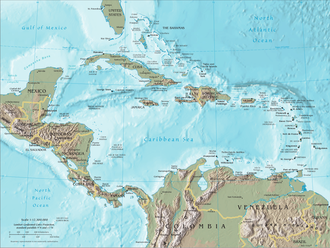
Back Karibiese gebied Afrikaans Karibik ALS ካሪቢያን Amharic الكاريبي Arabic كاريبى ARZ Caribe (rexón) AST Kariba is Antilla AVK Karib hövzəsi Azerbaijani کارائیپ AZB Karibe BCL
 Map of the Caribbean region of the Americas | |
| Area | 239,681 km2 (92,541 sq mi) |
|---|---|
| Population | 44,182,048[1][2] |
| Population density | 151.5/km2 (392/sq mi) |
| Ethnic groups | Afro-Caribbean Latin-Caribbean Indo-Caribbean White-Caribbean Mixed-Caribbean Asian-Caribbean Indigenous |
| Religions |
|
| Demonym | Caribbean, West Indian |
| Countries | |
| Dependencies | see below |
| Languages | |
| Time zones | UTC−05:00 to UTC−04:00 |
| Internet TLD | Multiple |
| Calling code | Multiple |
| Largest cities | |
| UN M49 code | 029 – Caribbean419 – Latin America and the Caribbean019 – Americas001 – World |
The Caribbean (/ˌkærɪˈbiːən, kəˈrɪbiən/ KARR-ih-BEE-ən, kə-RIB-ee-ən, locally /ˈkærɪbiæn/ KARR-ih-bee-an;[4] Spanish: el Caribe; French: les Caraïbes; Dutch: de Caraïben) is a region in the middle of the Americas centered around the Caribbean Sea in the North Atlantic Ocean, mostly overlapping with the West Indies. Bordered by North America to the north, Central America to the west, and South America to the south, it comprises numerous islands, cays, islets, reefs, and banks. It includes the Lucayan Archipelago, Greater Antilles, and Lesser Antilles of the West Indies; the Quintana Roo islands and Belizean islands of the Yucatán Peninsula; and the Bay Islands, Miskito Cays, Archipelago of San Andrés, Providencia, and Santa Catalina, Corn Islands, and San Blas Islands of Central America. It also includes the coastal areas on the continental mainland of the Americas bordering the region from the Yucatán Peninsula in North America through Central America to the Guianas in South America.[5][6]
- ^ "World Population Prospects 2022". United Nations Department of Economic and Social Affairs, Population Division. Retrieved July 17, 2022.
- ^ "World Population Prospects 2022: Demographic indicators by region, subregion and country, annually for 1950-2100" (XSLX) ("Total Population, as of 1 July (thousands)"). United Nations Department of Economic and Social Affairs, Population Division. Retrieved July 17, 2022.
- ^ Johnson, Todd M.; Crossing, Peter F. (14 October 2022). "Religions by Continent". Journal of Religion and Demography. 9 (1–2): 91–110. doi:10.1163/2589742x-bja10013.
- ^ Cite error: The named reference
dcewas invoked but never defined (see the help page). - ^ Engerman, Stanley L. (2000). "A Population History of the Caribbean". In Haines, Michael R.; Steckel, Richard Hall (eds.). A Population History of North America. Cambridge University Press. pp. 483–528. ISBN 978-0-521-49666-7. OCLC 41118518.
- ^ Hillman, Richard S.; D'Agostino, Thomas J., eds. (2003). Understanding the contemporary Caribbean. London, UK: Lynne Rienner. ISBN 978-1588266637. OCLC 300280211.
